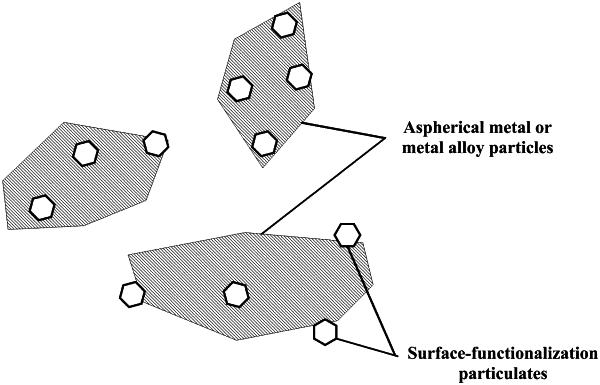| CPC C22C 1/05 (2013.01) [B22F 1/05 (2022.01); B22F 1/054 (2022.01); B22F 1/062 (2022.01); B22F 1/068 (2022.01); B22F 1/145 (2022.01); B22F 1/16 (2022.01); B22F 1/17 (2022.01); B22F 9/04 (2013.01); B22F 2009/043 (2013.01); B22F 2009/045 (2013.01); B22F 2304/05 (2013.01); B22F 2304/10 (2013.01); B22F 2304/15 (2013.01); B22F 2998/10 (2013.01)] | 11 Claims |

|
1. A metal-containing functionalized material comprising:
(a) a plurality of aspherical particles comprising a wrought aluminum alloy, wherein said aspherical particles are produced by a process comprising mechanically milling and/or chemically milling a bulk feedstock containing a bulk wrought metal alloy, wherein said mechanically milling and/or chemically milling causes no solid-liquid phase change during conversion of said bulk wrought aluminum alloy into said aspherical particles; and
(b) a plurality of particulates that are physically and/or chemically assembled on surfaces of said aspherical particles, wherein said particulates are selected from the group consisting of metals, metal alloys, metal carbides, metal nitrides, metal borides, metal hydrides, metal oxides, metal sulfides, ceramics, and combinations thereof,
wherein said particulates are compositionally different than said aspherical particles,
wherein said particulates have an average particulate size that is different than an average aspherical-particle size of said aspherical particles, and
wherein said aspherical particles are characterized by a packing efficiency selected from 49% to 56%.
|